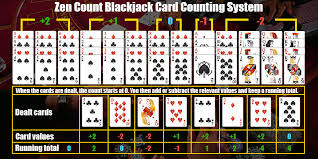
The Zen Count card counting system was developed by blackjack expert Arnold Snyder and was introduced in his book Blackbelt in Blackjack. This is just one of a few card counting systems Snyder developed.
Though he was a master card counter, Snyder developed systems that were simple enough for a beginner to work with, yet effective and efficient enough that an advanced player would be willing to work with it.
The Zen Count is a level 2, balanced system with parts that would require some practice at home before trying to use it at a live table game.
The indices range from -2 to +2, which is why it’s a level 2 system and it’s considered balanced because if you were to count down a deck, you would start and end with zero.
Because a true count, instead of running count, is used, it is considered slightly more difficult to learn. Figuring out the true count is not really that difficult, it’s just adds to the process, making it a little more involved.
True count with this system is determined by dividing the running count by the estimate of remaining decks in play. A true count is designed to give the player a more accurate representation of the remaining cards and how favorable or not it is to the player.
One point about this system is that using a true count is actually optional, The Zen Count can be used profitably with just the running count, but if you incorporate the true count, it will definitely give you an even greater edge.
How it Works
Each card in the deck is assigned a value of -2, -1, 0, +1, or +2. The chart of values is:
| 2 | 3 | 4 | 5 | 6 | 7 | 8 | 9 | 10 | J | Q | K | A |
| +1 | +1 | +2 | +2 | +2 | +1 | 0 | 0 | -2 | -2 | -2 | -2 | -1 |
As the cards are dealt, a running count is kept. The count does start at 0 and is increased or decreased per the value of the card dealt. You will then need to convert the running count to the true count (optional) before deciding on your bet.
Your running count will revert back to zero once the cards are shuffled.
ACE TRACKING
Fortunately, keeping track of aces on the side is not part of this system because they are given a value within the system. Snyder figured that accounting for aces with a -1 value, was just as effective as eliminating them from the running count or tracking them separately. This is what the more advanced players like about the system, one less thing to track.
SIZING YOUR BETS
Whether you’re using the running count or true count, a positive count is the signal to increase your bet and a negative count is the signal to bet the table minimum. Consequently, as the number increases, you want to increase your bet, in hopes of winning more, and if the count goes negative, bet the minimum or even think of moving to another table.
Try not to dramatically increase your bet if the count increases significantly, because you will probably draw unwanted eyes to your play. Play with a betting system that will keep your raises moderate, in order to not look like you’re counting cards.
As long as you don’t make wild jumps in betting amounts, you should be okay. Casinos understand that players will bet more if the cards seem to be “running good,” just don’t let them figure out just how much you know!
FINAL THOUGHTS
The Zen Count system is best used by an experienced card counter who wants to take their skills to the next level. You can first learn it using the running count, and then take the next step and add the use of the true count. Lastly, it works well with single deck or multiple deck games.



